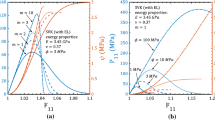Abstract
This paper develops a parametrically homogenized continuum damage mechanics (PHCDM) model for unidirectional fiber-reinforced composites undergoing progressive damage. The PHCDM models are designed to overcome limitations of prohibitive computational overhead associated with many homogenization methods. They are thermodynamically consistent, reduced-order continuum models with explicit representation of microstructural morphology. The PHCDM model is derived from detailed micromechanics of representative volume element (RVE) using energy equivalence principles. Micromechanical failure is due to fiber–matrix interface debonding and matrix cracking. The macroscopic PHCDM models represent damage anisotropy through a second-order damage tensor that contributes to the evolution of a damage surface in the space of damage work conjugate. The damage surface characterizes the initiation and evolution of damage. The constitutive relation between damage and its work conjugate is represented by an anisotropic fourth-order damage surface tensor \(P_{ijkl}\), whose components are expressed as functions of current damage state and composite morphology. These are calibrated and validated from homogenized micromechanical (HMM) responses. The PHCDM model is incorporated in a commercial finite element code, and analysis of macroscopic composite components is executed for understanding concurrent damage at multiple material length scales.
Access this chapter
Tax calculation will be finalised at checkout
Purchases are for personal use only
Similar content being viewed by others
References
Bazant Z, Pijaudier-Cabot G (1988) Nonlocal continuum damage, localization instability and convergence. J Appl Mech 55(2):287–293
Feyel F, Chaboche JL (2000) Fe\(^2\) multiscale approach for modelling the elastoviscoplastic behaviour of long fibre sic/ti composite materials. Comput Meth Appl Mech Eng 183:309–330
Hansen U, Gillespie J (1998) Dependence of intralaminar fracture toughness on direction of crack propagation in unidirectional composites. J Compos Technol Res 20(2):89–99
Kachanov L (1986) Introduction to continuum damage mechanics. M. Nijhoff, Dordrecht, Boston
Lemaitre J, Chaboche J-L (1994) Mechanics of solid materials. Cambridge University Press
Li Z, Ghosh S, Getinet N, O’Brien DJ (2016) Micromechanical modeling and characterization of damage evolution in glass fiber epoxy matrix composites. Mech Mater 99:37–52
Murakami S (2012) Continuum damage mechanics. Springer, The Netherlands
Park K, Paulino G (2011) Cohesive zone models: a critical review of traction-separation relationships across fracture surfaces. Appl Mech Rev 64:060802-1-060802-20
Park K, Paulino G (2012) Computational implementation of the ppr potential-based cohesive model in abaqus: educational perspective. Eng Fract Mech 93:239–262
Park K, Paulino G, Roesler J (2009) A unified potential-based cohesive model of mixed-mode fracture. J Mech Phy Solids 57:891–908
Raghavan P, Ghosh S (2005) A continuum damage mechanics model for unidirectional composites undergoing interfacial debonding. Mech Mater 37(9):955–979
Author information
Authors and Affiliations
Corresponding author
Editor information
Editors and Affiliations
Rights and permissions
Copyright information
© 2019 The Minerals, Metals & Materials Society
About this paper
Cite this paper
Zhang, X., Li, Z., O’Brien, D.J., Ghosh, S. (2019). Parametrically Homogenized Continuum Damage Mechanics (PHCDM) Models for Composites from Micromechanical Analysis. In: TMS 2019 148th Annual Meeting & Exhibition Supplemental Proceedings. The Minerals, Metals & Materials Series. Springer, Cham. https://doi.org/10.1007/978-3-030-05861-6_64
Download citation
DOI: https://doi.org/10.1007/978-3-030-05861-6_64
Published:
Publisher Name: Springer, Cham
Print ISBN: 978-3-030-05860-9
Online ISBN: 978-3-030-05861-6
eBook Packages: Chemistry and Materials ScienceChemistry and Material Science (R0)




